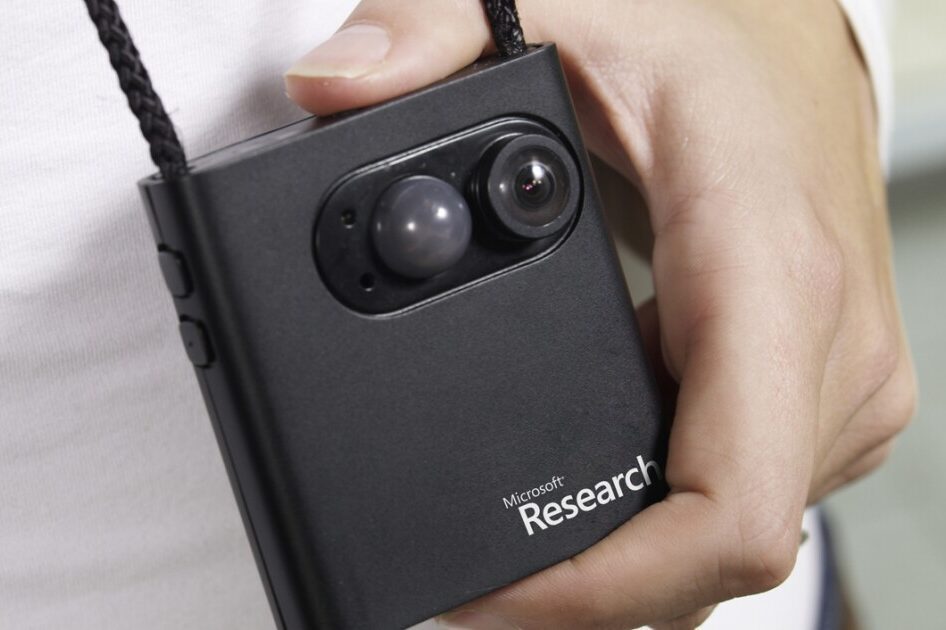SenseCam is a wearable digital camera that captures an electronic record of the wearer’s day. It does this by automatically recording a series of still images through its wide-angle lens, and simultaneously capturing a log of data from a number of built-in electronic sensors.
SenseCam Aids Memory
SenseCam aids memory by creating a personal multimedia lifelog, or visual recording of the wearer’s life. Subsequently reviewing a sequence of images appears to provide a powerful autobiographical memory cue. A preliminary evaluation of SenseCam with a patient diagnosed with severe memory impairment was extremely positive; periodic review of images of events recorded by SenseCam resulted in significant recall of those events.
Using SenseCam to Alleviate Memory Loss
Early on in the development of SenseCam, we became aware of the work of the Memory Clinic and Memory Aids Clinic at Addenbrooke’s Hospital, Cambridge, UK. This is a centre of excellence in the UK for diagnosing various conditions that affect memory, and for working with patients to try and mitigate their symptoms. While there are established techniques to help people remember to do things (i.e. supplement their prospective memory), there are very few aids that complement autobiographical memory, i.e. support the remembrance of things done or experienced. The Memory Clinic was excited by the potential of SenseCam to help in this regard.
Remembering an Event with SenseCam
We started a trial with a 63-year-old patient from the clinic with amnesia resulting from a brain infection. The patient, Mrs. B, was given a SenseCam and asked to wear it whenever she anticipated a ‘significant event’ – the sort of event that she would like to remember (i.e. not just something routine or mundane).
After wearing SenseCam for the duration of such an event, Mrs. B would spend around one hour reviewing the images every two days, for a two-week period.
Memory Increased
Without any aids to recall, Mrs. B typically completely forgets everything about an event after five days or less. However, during the course of this period of assisted recall using SenseCam, Mrs. B’s memory for the event steadily increased, and after two weeks she could recall around 80 percent of the event in question. What is perhaps more remarkable is that following the two-week period of aided recall, Mrs. B appears to have a lasting ability to recall the event even without reviewing the images.
The results of that initial trial with SenseCam are shown here:
Following the success of the first trial and the excitement it generated in both the research and clinical rehabilitation communities, Microsoft Research made SenseCam devices available to a large number of researchers and also initiated additional trials related to SenseCam’s use as a memory aid.
Today’s Photos Vs. Diary
Using SenseCam seems to be a very positive experience for most of the patients involved. Many have reported enjoying using it and reviewing images of their experiences, explaining that it makes them feel much more confident and relaxed. This is in stark contrast to the use of a written diary, which patients typically report has the opposite effect. Carers have also reported that they find SenseCam very beneficial. Here are some of the things that patients and their carers have said about SenseCam:
- “I am less anxious, because it helps to settle, or verify, what actually happened…”
- “It has enormous potential as a memory aid and has been a great success for us personally.”
- “Looking at the images is definitely helpful… they cue memories of things I would normally just forget.”
- “SenseCam is a Godsend… everyone should have one!”
- I am “more relaxed socially and less anxious.”
- “Sharing experiences again is a sheer pleasure.”
Reviewing Images At Home?
This research by Microsoft is exciting and should be easy enough to replicate. Microsoft Research’s SenseCam is an experimental device not available to the general public. Notwithstanding, many apps and reminiscence therapy programs can readily be used with a little creativity, to aid memory by reviewing images.
The post SenseCam Photos Ease Memory Loss appeared first on Alzheimer's & Dementia Weekly.
Publisher: Source link




